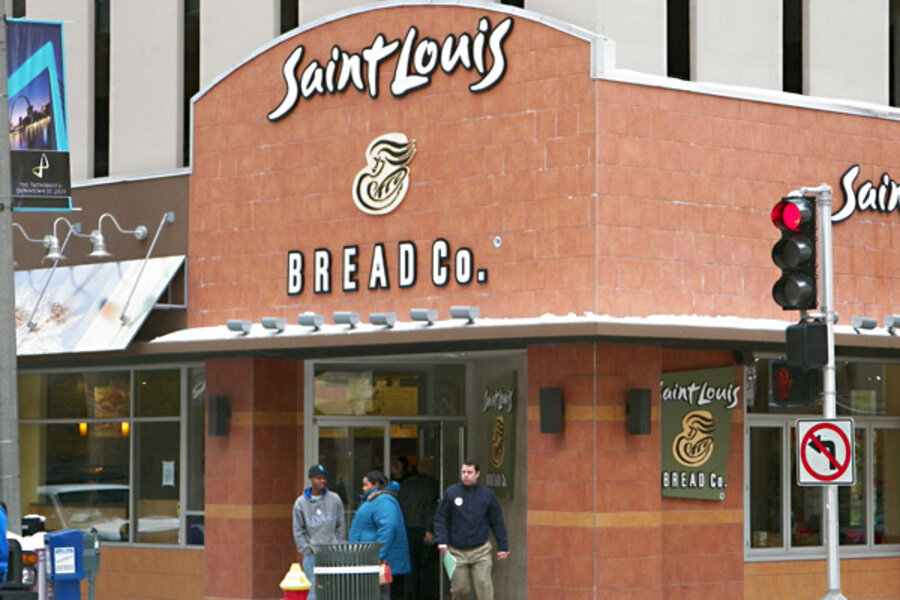Panera pay-what-you-want chili introduced in St. Louis stores
Loading...
Panera is mostly known for its bread bowls, but the café chain is making another name for itself in the arena of hunger awareness.
On Wednesday, the St. Louis-based company introduced a ‘pay-what-you-want’ turkey chili entree on its menus in the 48 locations in its hometown, where it operates as “St. Louis Bread Co.”
Dubbed “The Meal of Shared Responsibility,” the chili comes in a bread bowl and is served with chips, a baguette, or an apple on the side. Suggested retail price is $5.98, but customers can pay more, or less, or even nothing. The idea, as with other pay-what-you-can models, is that those ponying up more cash will pick up the tab for those who can’t afford to pay full price, or anything.
The launch puts a corporate face on the idea of community cafés and the gift economy, which heretofore has been the domain of smaller, locally run organizations.
“We know that one in six Americans – over 50 million people nationwide – are food insecure, meaning they have limited or uncertain access to adequate food,” Panera founder Ron Saich said in the Panera press release. “While this meal will obviously not eradicate hunger in St. Louis, we believe it’s a step in the right direction…. [W]e’re asking our communities to join together to share in the responsibility of paying it forward to help their neighbors.”
Why turkey chili? “One of the main issues with hunger is [lack of] access to nutritious foods,” says Panera Cares spokeswoman Kate Antonacci via telephone. (Panera Cares is the charitable arm of the company.) “If someone is only getting one meal a day, we want it to be filling and nutritious.”
To that end, the entrée is full of beans and assorted vegetables, and is high in protein and fiber. So far, there are no plans to introduce the concept in other locations, or expand it to other menu items. “We’re really using this as a test to see what people will do, so we can’t commit until we have a better idea,” Ms. Antonacci says.
With the “Meal of Shared Responsibility,” Panera is slowly introducing its charitable anti-hunger efforts to its mainstream clientele. The café chain, which operates about 1,600 locations nationwide, already runs pay-what-you-can restaurants, called “Panera Cares” cafés in five major cities: St. Louis, Detroit, Portland, Chicago, and most recently, Boston. The cafés look and feel just like Panera restaurants, but there are only suggested prices, and no cash registers.
“It's really more 'pay what you can.' We’re not looking to make any money there, just to sustain the concept itself,” according to Antonacci. She says that about 60 percent of customers pay the suggested price, 15 to 20 percent pay more, and 15 to 20 percent pay less or nothing. The restaurants generally break even, and any extra is donated to local hunger charities.
Panera is the first major chain to try a ‘pay what you can’ model, giving an increasingly popular concept in the anti-hunger nonprofit world even more steam. The Panera cafés were inspired by smaller operations around the country, including the SAME (So All May Eat) Café in Denver and the One World Everybody Eats (OWEE) café in Salt Lake City. In 2011, singer Jon Bon Jovi opened the JBJ Soul Kitchen in Red Bank, N.J. The restaurant encourages patrons to pay what they are able, and if they can’t pay, an hour of volunteering will cover their meal.
“At the end of the day it’s really a psychological experiment of sorts,” Antonacci says “More than anything we’re doing this to elevate the discussion and raise awareness, and provide a wholesome meal to people regardless of their means.”
“There are a lot of people who want to do something in their community but it can be kind of hard,” she adds. “This makes it easy.”
Time will tell whether other chains will launch similar efforts. But for now, Panera's work is bringing the community café concept to a wider swath of customers.








